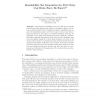Free Online Productivity Tools
i2Speak
i2Symbol
i2OCR
iTex2Img
iWeb2Print
iWeb2Shot
i2Type
iPdf2Split
iPdf2Merge
i2Bopomofo
i2Arabic
i2Style
i2Image
i2PDF
iLatex2Rtf
Sci2ools
APN
2004
Springer
2004
Springer
Reachability Set Generation for Petri Nets: Can Brute Force Be Smart?
Generating the reachability set is one of the most commonly required step when analyzing the logical or stochastic behavior of a system modeled with Petri nets. Traditional “explicit” algorithms that explore the reachability graph of a Petri net require memory and time at least proportional to the number of reachable markings, thus they are applicable only to fairly small systems in practice. Symbolic “implicit” algorithms, typically implemented using binary decision diagrams, have been successfully employed in much larger systems, but much of the work to date is based on breadth-first search techniques best suited for synchronous hardware verification. Here, instead, we describe recentlyintroduced data structures and algorithms particularly targeted to Petri nets and similar asynchronous models, and show why they are enormously more efficient for this application. We conclude with some directions for future research.
| Added | 30 Jun 2010 |
| Updated | 30 Jun 2010 |
| Type | Conference |
| Year | 2004 |
| Where | APN |
| Authors | Gianfranco Ciardo |
Comments (0)

